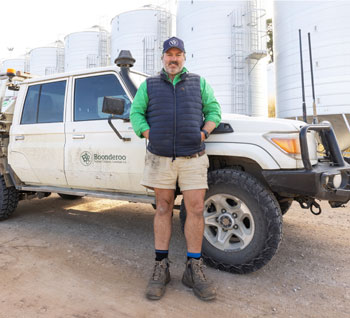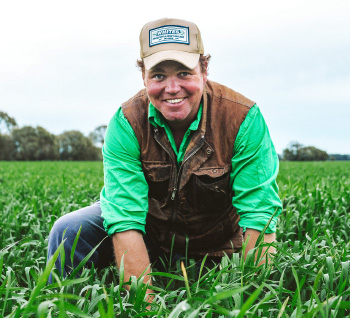Each year, GroundCover™ follows a group of growers across Australia as they manage their cropping season. In this fifth instalment, they report on how the season is shaping up. A dry – and therefore late – seasonal start for Mitch Henderson means most of his family has avoided frost. Lachie Sears says conditions are very dry with rainfall half of what his family typically records. While up in Central Queensland, the prospect of summer storms has led to contour bank maintenance
Western Australia
Mitch and Emma Miolini farm with his brother Adam, sister-in-law India and parents Robert and Maxine. The Miolini family are fourth-generation farmers at Mt Walker in Western Australia, 40 kilometres east of Narembeen in the central wheatbelt. Their enterprise is a mixed farm, cropping wheat, canola, oats, barley and lupins and running 1500 head of breeding ewes.
September saw us in a holding pattern as we waited for crops to mature. Our investment in plozza ploughing and deep ripping constrained soils means crops have developed a more expansive root system accessing moisture at depth. Crops have been looking lush and green, benefiting from a season with few prevailing, drying winds, and we anticipate an above-average year.
Barley heads were full and wheat was finishing well. The short-season wheat VixenA was filling three to four grains wide in florets and proving a better choice for the season and environment than Scepter . Still, it’s always good insurance to have a selection of different varieties in the cropping program.
Disease loads have been low this season and canola was swept for bugs in late September.
Pasture paddocks are being tidied up for weeds and fat lambs are being turned off for a good price. Although the WA sheep industry hit troublesome times this year, sheep will always be part of the business. They help to spread financial risk, are a valuable weed management tool and enable a diversified rotation. Pastures with vetch make a valuable contribution via green manuring.
Harvest delivery issues are being updated with additional segregations available at the local CBH receival and a new oat stack will mean delivering milling oats for the first time.
Field days have been attended and we have noted with interest a new biological control agent for skeleton weed. We are encouraged by increased activity in extension work for legumes in the district through the Grower Group Alliance’s Corrigin Farm Improvement Group.
Diesel mechanic skills are being put to use to service both our harvesters and those of neighbours and friends. Having this skill within the family business means cost savings and the additional small income stream supports the family holiday fund for a planned 10 days in Exmouth before harvest ramps up.
Victoria
 Mitch Henderson says a late plant meant only 10 to 15 per cent of yield potential was lost to frost rather than a total wipe-out. Photo: Brad Collis
Mitch Henderson says a late plant meant only 10 to 15 per cent of yield potential was lost to frost rather than a total wipe-out. Photo: Brad Collis
Mitch Henderson, with parents Craig and Pauline, brother Ben, cousin John and their families grow wheat, barley, lentils and oaten hay in Berriwillock, Wilkur and Brim in Victoria’s Mallee. They also rear poultry, using their wheat straw as bedding and then spreading it back onto paddocks as manure in a closed-loop system.
We’ve done a Steven Bradbury this year. Because we were behind our usual schedule (with dry sowing conditions delaying germination) most of our crops avoided major frost damage. We’ve only lost about
10 to 15 per cent of yield potential in our worst paddocks rather than a total wipe-out.
We only received 90 to 110 millimetres of growing season rainfall across our properties and moisture stress has amplified the impact of frost, so we’re counting our blessings we didn’t have too much crop out of the ground early. Our minimum-till system and good weed control in the summer fallow means that even with the decile 1 to 2 growing season rainfall, we’ll still have a crop, which historically probably wouldn’t have been the case.
We cut our planned export oats in September, and selectively cut some wheat for hay, rather than taking it to grain, as a ryegrass control mechanism. We saw less efficacy from the pre-emergent herbicide due to the dry start – not getting enough rainfall to activate it properly – so we cut before the ryegrass set seed.
People might think I’m mad because the wheat could go up to three tonnes per hectare and I’m cutting it for hay, but we’re taking a long-term approach, economically and agronomically.
Even with low rainfall we still had rust in our wheat. Scepter ’s resistance has been breaking down and we didn’t have flutriafol on the fertiliser, so we did a second spray late September. But we didn’t go as hard with fungicide as we would normally.
Most people are focused on breaking even rather than making any real money this year, but we’ve had four good seasons previously. Farming is a calculated risk, and you win some and lose some, so the system has to be able to pivot based on seasonal conditions.
We try to trim the fat when we’re going into a lean period, minimising any unnecessary expenditure. We don’t plan to use contract harvesters this year and just a small amount of contract cartage, so that bill will be significantly less. Because it’s a lighter year, finishing harvest before December is definitely on the cards.
South Australia
 Lachie Seears sells grain stored on his family’s mixed farm near Lucindale, South Australia, to dairy farmer clients year-round. Photo: Adrian Gale
Lachie Seears sells grain stored on his family’s mixed farm near Lucindale, South Australia, to dairy farmer clients year-round. Photo: Adrian Gale
Lachie Seears farms with his wife Rebecca, children Hugh and Anneliese, and his parents, Peter and Helen, near Lucindale in south-eastern South Australia. Their 6000ha enterprise comprises cropping (wheat, canola and broad beans), 6500 breeding ewes and 1250 breeding cows and heifers (building towards 2000 breeders).
We received 327mm of rain to 30 September, well under our long-term average. We farm in a 650mm-plus area.
Typically, waterlogging is our biggest constraint, but we have not seen any this year. We had 65mm in June, 77mm in July, 65mm in August and 48mm in September.
At the end of September, our broad bean and canola crops were still flowering and a long way from grain fill. We have subsoil moisture, but the crops need a couple of good rains to finish.
Our crops are more even this year. We don’t have those wet patches we usually see, which lower our average yields.
Something I have noticed this year is our crops’ extensive root development. This is because they had to search for moisture early on. With moisture in abundance, the root system does not have to work very hard and tends to be smaller, so bigger root systems might help us later in the season.
We have had some frost, which isn’t ideal, but the low temperature did not persist for long. We will have to wait and see if there is any damage.
The broad beans are a long way behind where they would generally be and they are my biggest concern.
Our long-season winter wheat flowers from late October to early November. It must rely on stored soil moisture or some late spring rain to fill. The boomspray has not stopped with weed and fungicide treatments. We have found it difficult to find favourable days for spraying this winter and early spring because the wind has been relentless.
We added another urea application to the canola but will wait and see if there is further rain in spring before adding more to the wheat. Our production and marketing system is geared towards grain supply to diverse users. We truck wheat to our dairy farmer clients year-round.
New South Wales
 Andrew Freeth in a wheat crop in early August. Photo: Kirsty Fisher
Andrew Freeth in a wheat crop in early August. Photo: Kirsty Fisher
Andrew Freeth, his parents David and Sue, and his brother Marc grow wheat, canola, chickpeas, faba beans, 2200 Merino ewes and trade cattle near Collie and Trangie in central New South Wales.
We recorded 29mm of rain from 14 to 17 August, which was our last effective rainfall. Only 6mm fell over four days in September.
Fortunately, we avoided the severe frost experienced in much of southern and central NSW in mid-September. But we did receive some frost damage in faba beans in early September. The lack of September rainfall took the top end off our yields potential, but we remain quietly optimistic we can achieve above-average yields as our crops access stored subsoil moisture to fill.
Our ewe hoggets and weaners were removed from the Illabo wheat, and we locked those crops up for grain production.
We applied a third urea application to the wheat, taking the total input to 300kg/ha.
No fungicides were applied to wheat because we grow disease-resistant varieties.
We considered applying fungicide to the canola, but the outlook was dry, so we held off. The faba beans had two fungicide sprays, and the chickpeas had three, with another budgeted for before harvest if required.
On 4 October, there was little rain forecast for October. A late September to early October rain would have benefited our chickpeas the most because they were still flowering.
The faba beans had filled by late September, and the wheat was filling. We anticipate the faba beans will be ready to harvest first, possibly in the third or fourth week in October, followed by the canola, wheat and chickpeas.
We lined up our header contractor and completed final pre-season repairs and maintenance on our trucks and grain handling equipment. We cleaned down and prepared our grain storage assets in early October, moved around old-season grain in preparation for harvest, and repaired roads. Trucking chickpeas to market as soon as possible off the header will be critical.
Queensland
 Tim Gersbach is hosting a trial on the variable application of residual chemicals to help with summer grasses. Photo: Rowdy Travis
Tim Gersbach is hosting a trial on the variable application of residual chemicals to help with summer grasses. Photo: Rowdy Travis
Based at Capella, north of Emerald, in Central Queensland, Tim Gersbach farms 4000ha with his wife Courtney, their two young children, and his parents Garry and Cathy. They crop wheat, chickpeas and, occasionally, mungbeans. Sorghum is the dominant summer crop.
We have been working on our sorghum stubble paddocks, spraying to control weeds using our optical spot sprayer. We had a bit of sorghum fall over this year, so we also ran a vertical tiller through it to chop it up a bit. Otherwise, it can be too hard to plant in.
We learnt from the GRDC RiskWi$e trial this year that you don’t lose as much nitrogen to the atmosphere as previously thought. It is only one year of data, but it makes sense for us to spread urea now. It is more convenient to do when we have the time and can easily get a truck to deliver it.
So, we have also put down 120kg/ha of urea on 1700ha of sorghum stubble paddocks. I’d like to longfallow them until next winter and plant wheat and chickpeas. If we get summer rain, the urea will wash in through the profile. We keep learning it is about ‘fertilising the system, not the crop’.
We are also hosting a trial on the variable application of residual chemicals to help with summer grasses. It is part of a GRDC investment led by Syngenta, which has partnered with RDO Equipment. The aim is to test how well you can tailor pre-emergent herbicide applications to paddock-based data. We have a new John Deere See & Spray™ coming, which will work well with the trial.
Otherwise, we are touching up a few of the contour banks. There is a bit of earthworks maintenance to get on with, so any potentially wild summer storms don’t see us having water banked up.
If we do get summer storms, we’ll plant sorghum. Even without the pressure of fall armyworm, it is not worth it financially, but is often our only option. We’d go sorghum over mungbeans.
Harvest was about a month late thanks to 206mm of in-crop rain. The chickpeas were a heavy crop with a lot of biomass. It meant a low ground speed on the headers.
Before that rain, the wheat was starting to stress. It had been planted deep at seven to 10cm in late April. It developed extra tillers, so we had to wait for the second tillers to finish up before harvesting.
See also: GroundCoverTM story – Healthy-looking crops point to a promising harvest

























































